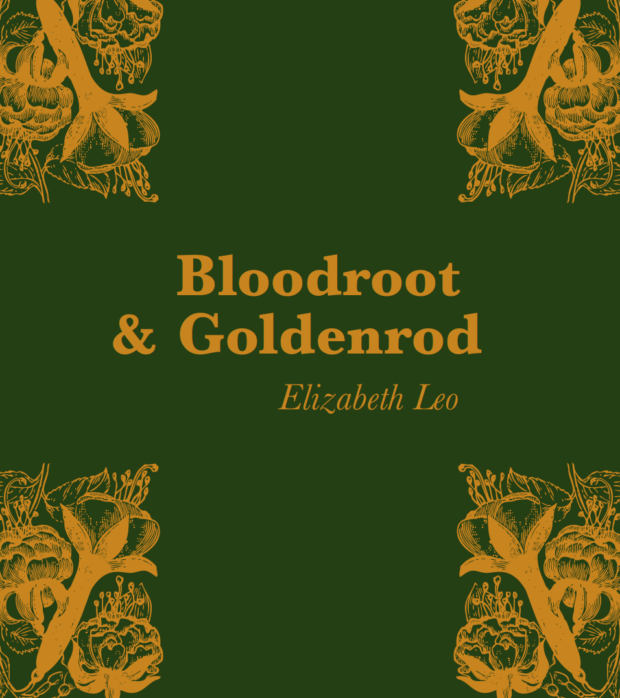When I learned of poet Elizabeth Leo’s death—at age 34, in 2019—I was genuinely surprised to hear of it, and deeply saddened. It seemed remarkable and confusing to me that a poet so much younger than I would no longer walk among us. I remembered her fondly from readings I had given in Philadelphia, particularly at Manayunk-Roxborough Art Center, where she volunteered for a time, served on the board, and organized planting and cleanup two springs. She consoled me when I was out of sorts and was a friendly and reassuring presence on the Philadelphia poetry scene. I regret I didn’t know more about her poetry, but it seems she was often reluctant to publish or otherwise share her poems. Now that I have had a chance to read them, in a limited-printing chapbook titled Bloodroot & Goldenrod, I find them evocative of Theodore Roethke’s as well as Amy Clampitt’s, where the processes and fantastic forms of nature are allowed to astound us as they take on deeper human meanings.
Poets Geoffrey Hilsabeck and Natalie Homer arranged for publication of the chapbook in 2020 through the West Virginia University School of Art and Design. It is a slender volume, containing a mere 20 poems—all stirring, striking, and haunting—alongside naturalist sketches found among the poet’s papers. We are pleased to share three of the poems below.
Elizabeth Leo (1984-2019) was a poet, teacher, and gardener. She earned a Bachelor’s degree in English from Albright University and an MFA in poetry from West Virginia University. A Philadelphia native, she lived in West Virginia until her death in 2019. She has poems published or forthcoming in Radar Poetry, The Boiler, Poet Lore, and Moon City Review. You can read Geoffrey Hilsabeck’s story of Bloodroot & Goldenrod‘s publication, along with sensitive commentary on Elizabeth’s poems and the circumstances surrounding her death. Click to visit the article over at The Millions.
“Cricket Season”
Mums and leg-fiddles on the air.
It is the season of astringents, of turning into
or turning away. The crickets sound quick
in the low weeds by the woods, but up here
on the porch boards they are huge, gun-gray
in the lamplight, are dead-slow, silent and heavy
as threat. Those away in the grass, they call
next, next, next: a tearing paper song.
Then, the startling luck-black of them beneath a begonia’s leaf
sings a deaf song, soon, soon.
The locust leaves are already yellow
and I am already sick of their falling.
I push my glasses on top of my head.
I let the world go blurry and still.
“Adiantum”
There was a magic cupboard and inside Adiantum danced.
Little girls could fall in sideways leaning too far
to sniff a heavy aster in the dark.
A heavy bloom in the dark.
A heavy bloom in the dark.
Flower as a cardinal destroyer, wrecker of hearts.
“One of Us Pulls Another’s Hair, So We Are Not Alone”
A creak from the rocker, we know
it’s not an empty chair. We seek belief
in shoveling soil, in blisters.
And we find it there. There. There is no trouble
and the garden is lucky in the sun,
brothers. Running waters unfurl the ferns.
Let’s follow, together, the moonflower
tonight, when it blooms a silver trumpet
in another tended clearing. Let’s bend
the staring moon in our cupped hands, tether
our startled bodies to the stars like this.
And when they fall away, we fall away
with them, nest with night birds, rest until day.
We find it there. There, there. The garden lights:
the grays collect at the end of the sky.
From the preface to the chapbook:
Elizabeth Leo (1984-2019) was a poet, teacher, and gardener. She was good at helping things grow. She was shy and kind and generous, full of secret reserves and keen judgments. Full of talent and promise but afraid of rejection, Elizabeth avoided making her work public during her life. But her poems need readers. They deserve to circulate. We selected and edited the poems in Bloodroot & Goldenrod from her relatively small oeuvre with the hope that they would find those readers.
Elizabeth’s poems are all heavy blooms and hidden centers, insistent but unmannered repetitions. They circle obsessively around an unnamed absence. Loss gives them their urgency, their dark humor, and their beauty. They risk beauty. They do not suppress their desire to sing, full-throated and purple-stained, to quote John Keats (who hovers in the background of so many of these poems). These poems have a large future. They contain with them so many possible roads Elizabeth might have traveled as a poet. We wanted that future to be present in the collection. We wanted to account not only for the poet she was, but the poet she might have become. In odd, startling moments she moves beyond the influence of her mentors, moves in the direction not of what a poem should be but what, in her hands, it is. Her authority emerges. These are small moments, small and painful, because to see all that—in a turn of
phrase or a stanza break—is to feel the loss very acutely. – Geoffrey Hilsabeck and Natalie Homer, Morgantown, West Virginia



No Comments